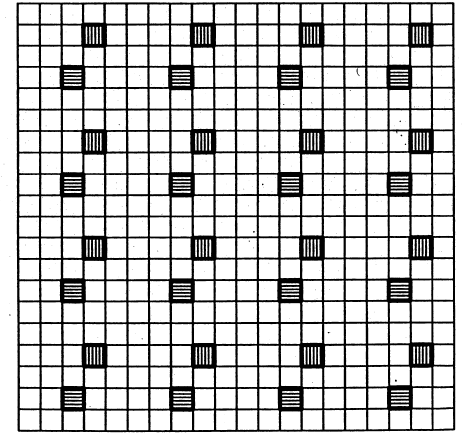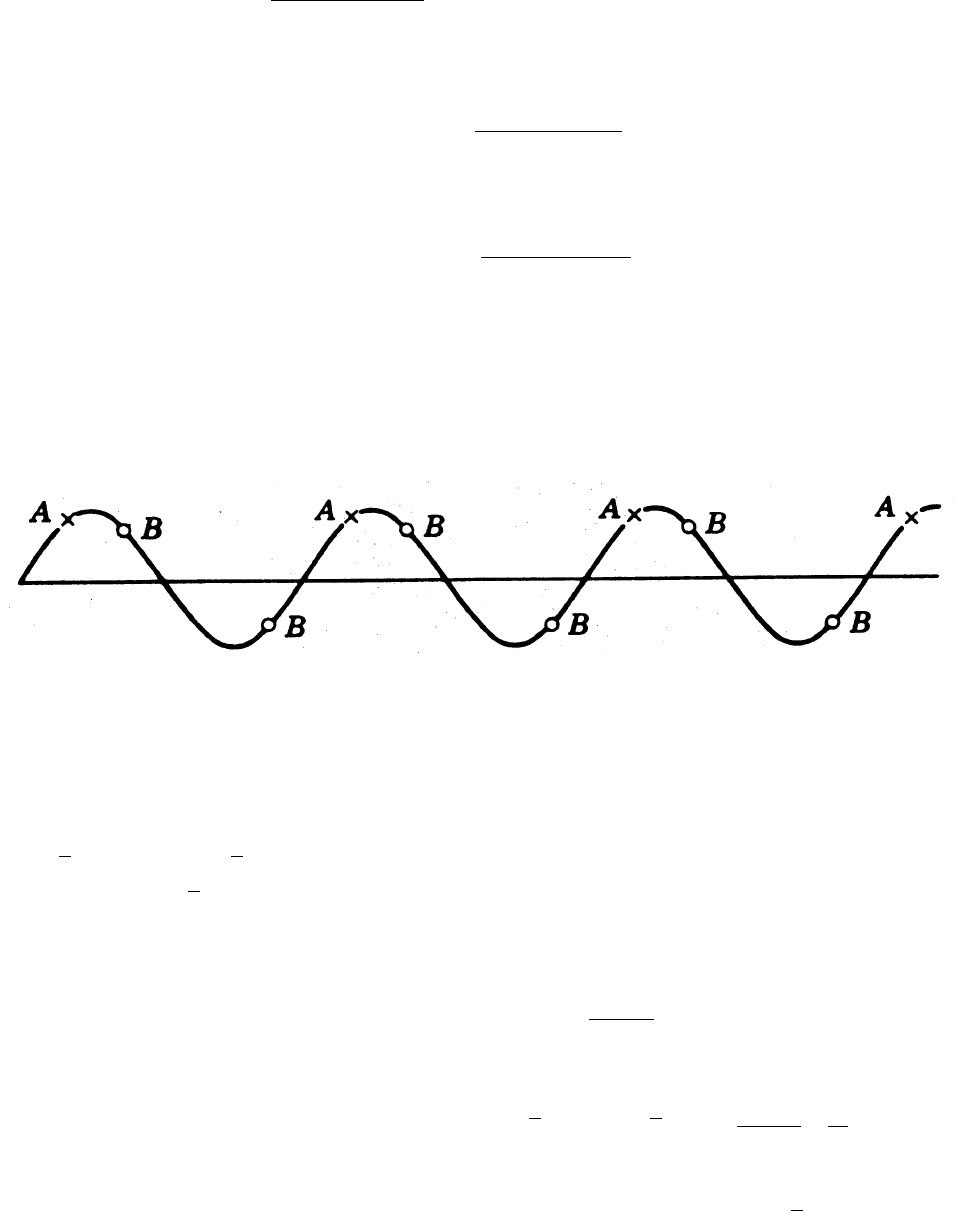
7.4 Systematic Sampling
• Systematic sampling is a sampling plan in which the population units are collected
systematically throughout the population. More specifically, a single primary sampling
unit consists of secondary sampling units that are relatively spaced with each other in
some systematic pattern throughout the population.
• Supp ose the study area is partitioned into a 20 × 20 grid of 400 population units. A
primary sampling unit in a systematic sample could consist of all population units that
form a lattice which are 5 units apart horizontally and vertically. In Figure 9a, N = 25
and M = 16. In Figure 9b, each of the N = 50 primary sampling units contains M = 8
secondary sampling units.
• Initially, systematic sampling and cluster sampling appear to be opposites because system-
atic samples contain secondary sampling units that are spread throughout the population
(go od global coverage of the study area) while cluster samples are collected in groups of
close proximity (good coverage locally within the study area).
• Systematic and cluster sampling are similar, however, because whenever a primary sam-
pling unit is selected from the sampling frame, all secondary sampling units of that primary
sampling unit will be included in the sample. Thus, random selection occurs at the primary
sampling unit level and not the secondary sampling unit level.
• For estimation purposes, you could ignore the secondary sampling unit y
ij
-values and only
retain the primary sampling units t
i
-values. This is what we did with one-stage cluster
sampling.
• The systematic and cluster sampling principle: To obtain estimators of low variance,
the population must be partitioned into primary sampling unit clusters in such a way that
157
7.4 Systematic Sampling
• Systematic sampling is a sampling plan in which the population units are collected
systematically throughout the population. More specifically, a single primary sampling
unit consists of secondary sampling units that are relatively spaced with each other in
some systematic pattern throughout the population.
• Suppose the study area is partitioned into a 20 × 20 grid of 400 population units. A
primary sampling unit in a systematic sample could consist of all population units that
form a lattice which are 5 units apart horizontally and vertically. In Figure 9a, N = 25
and M = 16. In Figure 9b, each of the N = 50 primary sampling units contains M = 8
secondary sampling units.
• Initially, systematic sampling and cluster sampling appear to be opposites because system-
atic samples contain secondary sampling units that are spread throughout the population
(good global coverage of the study area) while cluster samples are collected in groups of
close proximity (good coverage locally within the study area).
• Systematic and cluster sampling are similar, however, because whenever a primary sam-
pling unit is selected from the sampling frame, all secondary sampling units of that primary
sampling unit will be included in the sample. Thus, random selection occurs at the primary
sampling unit level and not the secondary sampling unit level.
• For estimation purposes, you could ignore the secondary sampling unit y
ij
-values and only
retain the primary sampling units t
i
-values. This is what we did with one-stage cluster
sampling.
• The systematic and cluster sampling principle: To obtain estimators of low variance,
the population must be partitioned into primary sampling unit clusters in such a way that
the clusters are similar to each other with respect to the t
i
-values (small cluster-to-cluster
variability).
161

• This is equivalent to saying that the within-cluster variability should be as large as pos-
sible to obtain the most precise estimators. Thus, the ideal primary sampling unit is
representative of the full diversity of y
ij
-values within the population.
• With natural populations of spatially distributed plants, animals, minerals, etc., these con-
ditions are typically satisfied by systematic primary sampling units (and are not satisfied
by primary sampling units with spatially clustered secondary sampling units).
7.4.1 Estimation of y
U
and t
• If a SRS is used to select the systematic primary sampling units, we can apply the estima-
tion results for cluster sampling to define (i) estimators, (ii) the variance of each estimator,
and (iii) the estimated variance of each estimator.
• The following formulas will be the same as those used for one-stage cluster sampling. The
subscript sys denotes the fact that data were collected under systematic sampling.
• The unbiased estimators of t and y
U
are:
b
t
sys
=
N
n
n
X
i=1
t
i
=
c
y
U
sys
=
1
nM
n
X
i=1
t
i
=
y
M
= (85)
with variance
V (
b
t
sys
) = V (
c
y
U
sys
) =
N(N −n)
M
2
0
S
2
t
n
(86)
where S
2
t
=
P
N
i=1
(t
i
− t
i
)
2
N −1
.
• Recall that y =
1
n
n
X
i=1
t
i
is the sample mean and that s
2
t
=
P
n
i=1
(t
i
− y)
2
n −1
is the sample
variance of the primary sampling units.
• Because S
2
t
is unknown, we use s
2
t
to get unbiased estimators of the variances:
b
V (
b
t
sys
) =
b
V (
c
y
U
sys
) =
N(N −n)
M
2
0
s
2
t
n
(87)
7.4.2 Confidence Intervals for y
U
and t
• For a relatively small number n of sampled primary sampling units, the following confi-
dence intervals are recommended:
c
y
U
sys
± t
∗
q
b
V (
c
y
U
sys
)
b
t
sys
± t
∗
q
b
V (
b
t
sys
) (88)
where t
∗
is the upper α/2 critical value from the t(n − 1) distribution. Note that the
degrees of freedom are based on n, the number of sampled primary sampling units, and
not on the total number of secondary sampling units nM.
162

Systematic Sampling Examples
In Figure 9a, each of the N = 25 primary sampling units contains M = 16 secondary sampling
units corresponding to the same location within the 16 5x5 subregions. n = 3 primary sampling
units were sampled. The SSUs sampled are in ( )
Figure 9a
1 1 (1) 1 1 2 1 (0) 0 0 4 5 (0) 1 0 1 2 (1) 0 1
3 2 1 0 1 0 0 0 1 2 2 2 0 2 2 2 0 2 0 1
7 (4) 1 1 1 1 (0) 0 0 2 2 (0) 4 3 2 4 (2) 1 2 2
0 1 2 0 0 0 0 0 4 6 5 1 5 0 0 0 2 1 2 0
1 1 0 (2) 3 2 0 0 (2) 1 3 1 4 (1) 1 1 2 2 (1) 1
2 0 (0) 0 4 3 3 (0) 1 16 5 0 (1) 3 8 0 0 (1) 3 3
0 0 1 14 3 3 1 2 0 8 0 2 0 3 9 0 4 2 1 0
0 (0) 5 1 8 7 (6) 6 6 1 0 (4) 0 0 1 2 (2) 0 1 2
0 0 2 2 3 2 2 3 1 1 1 3 0 0 2 2 0 3 4 0
0 0 0 (0) 1 0 3 1 (1) 1 2 0 2 (0) 2 0 2 1 (1) 0
1 8 (7) 7 8 0 5 (0) 1 0 1 2 (0) 0 2 4 2 (2) 2 4
0 9 1 0 0 1 1 1 0 0 0 1 2 4 0 2 1 3 3 1
0 (0) 0 1 0 2 (4) 3 1 2 2 (0) 0 1 1 2 (2) 0 2 4
0 1 0 0 1 2 0 2 3 5 2 0 0 2 1 1 2 0 1 3
1 0 0 (1) 1 0 0 0 (2) 2 2 1 1 (1) 0 0 2 0 (0) 0
0 2 (0) 2 2 0 1 (1) 0 2 0 0 (1) 0 0 1 1 (1) 5 3
0 0 0 3 2 1 0 0 0 0 0 2 1 0 1 1 1 3 1 2
1 (0) 0 1 0 3 (0) 1 0 0 2 (1) 2 0 0 0 (1) 1 1 0
0 0 0 0 0 0 0 1 1 1 0 1 0 3 0 2 0 1 1 0
2 0 0 (0) 0 0 0 0 (1) 2 0 1 3 (0) 0 1 0 1 (2) 4
The following are the 25 systematic PSU (cluster) totals (t
i
for i = 1, 2, . . . , 25). The sample
contains n = 3 PSU (3 starting locations). The PSUs sampled are in ( )
25 33 (16) 26 54
15 26 19 32 32
35 (26) 24 21 26
17 13 20 24 23
15 13 15 (15) 19
163

In Figure 9b, each of the N = 50 primary sampling units contains M = 8 secondary sampling
units corresponding to the same location within the 8 10x5 subregions. n = 6 primary sampling
units were sampled. The SSUs sampled are in ( )
Figure 9b
18 (20) 15 20 20 15 (19) 18 24 23 20 (26) 29 28 28 31 (31) 34 28 32
13 20 16 20 15 23 19 26 21 21 24 30 23 26 25 33 31 28 32 38
(16) 18 20 24 (25) (26) 22 23 26 (26) (22) 27 25 25 (34) (28) 37 36 38 (31)
17 17 16 22 21 23 22 27 27 24 28 32 29 33 27 37 37 38 35 33
15 19 23 17 21 23 21 23 24 25 31 26 32 34 32 33 31 31 36 37
21 (24) 20 21 28 26 (30) 22 31 25 29 (29) 27 30 29 37 (35) 32 38 43
23 17 24 25 24 27 31 29 31 34 27 36 29 29 34 39 37 37 40 36
(18) 24 21 25 27 (22) 32 32 31 26 (28) 34 34 37 35 (34) 38 38 37 40
22 26 28 (26) 24 29 33 26 (27) 27 34 31 39 (32) 36 38 37 40 (44) 43
23 27 28 29 26 32 25 31 35 34 32 33 37 32 42 40 40 37 42 44
23 (21) 31 23 30 27 (31) 30 32 35 30 (40) 32 37 37 36 (40) 44 44 40
26 29 31 26 30 31 34 36 30 38 36 32 38 38 37 42 42 41 40 49
(28) 24 28 27 (26) (31) 32 29 32 (33) (38) 34 39 38 (40) (37) 41 43 42 (43)
32 25 31 32 29 29 35 38 38 32 36 35 39 42 39 40 44 42 41 45
27 29 35 28 35 35 31 40 35 37 38 44 40 40 47 39 49 48 51 49
30 (29) 32 32 33 30 (36) 38 42 36 35 (38) 44 47 45 49 (41) 43 44 51
28 35 35 34 34 33 41 33 34 35 39 44 44 48 44 50 49 48 53 54
(29) 33 32 36 39 (33) 33 34 35 42 (46) 47 48 47 46 (45) 44 52 54 55
28 37 38 (37) 33 33 34 37 (45) 40 39 42 42 (46) 47 48 52 47 (46) 53
38 39 39 37 34 38 39 45 39 42 45 41 44 51 46 50 52 51 51 53
The following are the 50 systematic PSU (cluster) totals (t
i
for i = 1, 2, . . . , 50). The sample
contains n = 6 PSU (6 starting locations). The PSUs sampled are in ( )
200 (228) 233 236 245
228 237 239 233 253
(226) 235 243 252 (258)
242 247 260 270 250
241 250 272 265 283
257 (262) 258 285 290
266 290 279 294 295
(255) 285 291 302 310
271 292 297 (303) 303
298 296 312 316 321
164
7.4.3 Using R and SAS for Systematic Sampling
R code for Systematic Sample in Figure 9a
library(survey)
source("c:/courses/st446/rcode/confintt.r")
# Systematic sample of 3 PSUs from Figure 9a
N = 25
n = 3
M = 16
wgt = N/n
y <- c(1,0,0,1,0,0,1,1,7,0,0,2,0,1,1,1,
4,0,0,2,0,6,4,2,0,4,0,2,0,0,1,1,
2,2,1,1,0,1,0,1,1,2,1,0,0,1,0,2)
clusterid <- c(rep(c(1),M),rep(c(2),M),rep(c(3),M))
fpc <- c(rep(N,n*M))
Fig9a <- data.frame(cbind(clusterid,y,fpc))
dsgn9a <-
svydesign(ids=~clusterid,weights=c(rep(wgt,n*M)),fpc=~fpc,data=Fig9a)
esttotal <- svytotal(~trees,design=dsgn9a)
print(esttotal,digits=15)
confint.t(esttotal,level=.95,tdf=n-1)
estmean <- svymean(~trees,design=dsgn9a)
print(estmean,digits=15)
confint.t(estmean,level=.95,tdf=n-1)
R output for Systematic Sample in Figure 9a
total SE
y 475 82.361
-------------------------------------------------------------------
mean( y ) = 475.00000
SE( y ) = 82.36099
Two-Tailed CI for y where alpha = 0.05 with 2 df
2.5 % 97.5 %
120.62924 829.37076
-------------------------------------------------------------------
mean SE
y 1.1875 0.2059
-------------------------------------------------------------------
mean( y ) = 1.18750
SE( y ) = 0.20590
Two-Tailed CI for y where alpha = 0.05 with 2 df
2.5 % 97.5 %
0.30157 2.07343
-------------------------------------------------------------------
165
R code for Systematic Sample in Figure 9b
# Systematic sample of 6 PSUs from Figure 9b
N = 50
n = 6
M = 8
wgt = N/n
y <- c(20,19,26,31,21,31,40,40,16,26,22,28,28,31,38,37,
25,26,34,31,26,33,40,43,24,30,29,35,29,36,38,41,
18,22,28,34,29,33,46,45,26,27,32,44,37,45,46,46)
clusterid <- c(1,1,1,1,1,1,1,1,2,2,2,2,2,2,2,2,3,3,3,3,3,3,3,3,
4,4,4,4,4,4,4,4,5,5,5,5,5,5,5,5,6,6,6,6,6,6,6,6)
(The remainder of the code is the same as the previous example)
R output for Systematic Sample in Figure 9b
-------------------------------------------------------------------
mean( y ) = 12766.66667
SE( y ) = 536.93368
Two-Tailed CI for y where alpha = 0.05 with 5 df
2.5 % 97.5 %
11386.43470 14146.89863
-------------------------------------------------------------------
-------------------------------------------------------------------
mean( y ) = 31.91667
SE( y ) = 1.34233
Two-Tailed CI for y where alpha = 0.05 with 5 df
2.5 % 97.5 %
28.46609 35.36725
-------------------------------------------------------------------
SAS code for Systematic Sample in Figure 9a (Supplemental)
DATA systmtc1;
M0 = 400; * number of secondary sampling units (SSUs) in population;
M = 16; * number of SSUs in a PSU;
n = 3; * number of primary sampling units (PSUs) sampled;
wgt = M0/(n*M);
DO psu = 1 to n;
DO ssu = 1 to M;
INPUT trees @@; OUTPUT;
END; END;
DATALINES;
1 0 0 1 0 0 1 1 7 0 0 2 0 1 1 1
4 0 0 2 0 6 4 2 0 4 0 2 0 0 1 1
2 2 1 1 0 1 0 1 1 2 1 0 0 1 0 2
;
*** TOTAL = number of PSUs in the population ***;
PROC SURVEYMEANS DATA=systmtc1 TOTAL=25 MEAN CLM SUM CLSUM;
VAR trees;
CLUSTER psu;
WEIGHT wgt;
TITLE ’Systematic Sample from Figure 9a’;
RUN;
166
SAS output for Systematic Sample in Figure 9a
The SURVEYMEANS Procedure
Data Summary
Number of Clusters 3
Number of Observations 48
Sum of Weights 400
Statistics
Std Error
Variable Mean of Mean 95% CL for Mean
-----------------------------------------------------------------
trees 1.187500 0.205902 0.30157311 2.07342689
-----------------------------------------------------------------
Statistics
Variable Sum Std Dev 95% CL for Sum
-----------------------------------------------------------------
trees 475.000000 82.360994 120.629244 829.370756
-----------------------------------------------------------------
SAS code for Systematic Sample in Figure 9b (Supplemental)
DATA systmtc2;
M0 = 400; * number of secondary sampling units (SSUs) in population;
n = 6; * number of primary sampling units (PSUs) sampled;
m = 8; * number of SSUs in a PSU;
wgt = M0/(n*m);
DO psu = 1 to n; DO ssu = 1 to m;
INPUT y @@; OUTPUT;
END; END;
DATALINES;
20 19 26 31 21 31 40 40 16 26 22 28 28 31 38 37 25 26 34 31 26 33 40 43
24 30 29 35 29 36 38 41 18 22 28 34 29 33 46 45 26 27 32 44 37 45 46 46
;
*** TOTAL = number of PSUs in the population ***;
PROC SURVEYMEANS DATA=systmtc2 TOTAL=50 MEAN CLM SUM CLSUM;
VAR y; CLUSTER psu; WEIGHT wgt;
TITLE ’Systematic Sample from Figure 9b’;
RUN;
SAS output for Systematic Sample in Figure 9b
Data Summary
Number of Clusters 6
Number of Observations 48
Sum of Weights 400
Statistics
Std Error
Variable Mean of Mean 95% CL for Mean
-----------------------------------------------------------------
y 31.916667 1.342334 28.4660867 35.3672466
-----------------------------------------------------------------
Variable Sum Std Dev 95% CL for Sum
-----------------------------------------------------------------
y 12767 536.933681 11386.4347 14146.8986
-----------------------------------------------------------------
167

7.4.4 Comments from W.G. Cochran
• Cochran (from Sampling Techniques (1953)) makes the following comments about advan-
tages of systematic sampling:
Intuitively, systematic sampling seems likely to be more precise than simple random
sampling. In effect, it stratifies the population into [N] strata, which consist of the first
[M] units, the second [M ] units, and so on. We might therefore expect the systematic
sample to be about as precise as the corresponding stratified random sample with
one unit per stratum. The difference is that with the systematic sample the units all
occur at the same relative position in the stratum, whereas with the stratified random
sample the position in the stratum is determined separately by randomization within
each stratum. The systematic sample is spread more evenly over the population, and
this fact has sometimes made systematic sampling considerably more precise than
stratified random sampling.
• Cochran also warns us that:
The performance of systematic sampling relative to that of stratified or simple random
sampling is greatly dependent on the properties of the population. There are popu-
lations for which systematic sampling is extremely precise and others for which it is
less precise that simple random sampling. For some populations and values of [M ],
[ var(
c
y
U
sys
)] may even increase when a larger sample is taken — a startling departure
from good behavior. Thus it is difficult to give general advice about the situation in
which systematic sampling is to recommended. A knowledge of the structure of the
population is necessary for its most effective use.
• If a population contains a linear trend:
1. The variances of the estimators from systematic and stratified sampling will be smaller
than the variance of the estimator from simple random sampling.
2. The variance of the estimator from systematic sampling will be larger than the vari-
ance of the estimator from stratified sampling. Why? If the starting point of the
systematic sample is selected too low or too high, it will be too low or too high
across the population of units. Whereas, stratified sampling gives an opportunity for
within-stratum errors to cancel.
• Suppose a population has 16 secondary sampling units (t = 130) and is ordered as follows:
Sampling unit 1 2 3 4 5 6 7 8 9 10 11 12 13 14 15 16
y-value 1 2 2 3 3 4 5 6 8 9 12 13 14 15 16 17
Note there is a linearly increasing trend in the y-values with the order of the sampling
units. Suppose we take a 1-in-4 systematic sample. The following table summarizes the
four possible 1-in-4 systematic samples.
Sampling unit 1 2 3 4 5 6 7 8 9 10 11 12 13 14 15 16
y-values 1 2 2 3 3 4 5 6 8 9 12 13 14 15 16 17 t
i
b
t
sys
Sample 1 1 3 8 14
Sample 2 2 4 9 15
Sample 3 2 5 12 16
Sample 4 3 6 13 17
168

• If a population has periodic trends, the effectiveness of the systematic sample depends
on the relationship between the periodic interval and the systematic sampling interval or
pattern. The following idealized curve was given by Cochran to show this. The height of
the curve represents the population y-value.
– The A sample points represent the least favorable systematic sample because when-
ever M is equal to the period, every observation in the systematic sample will be
similar so the sample is no more precise than a single observation taken at random
from the population.
– The B sample points represent the most favorable systematic sample because M is
equal to a half-period. Every systematic sample has mean equal to the true population
mean because successive y-value deviations above and below the mean cancel. Thus,
the variance of the estimator is zero.
– For other values of M, the sample has varying degrees of effectiveness that depends
on the relation between M and the period.
• If a population has periodic trends, the effectiveness of the systematic sample depends
on the relationship between the periodic interval and the systematic sampling interval or
pattern. The following idealized curve was given by Cochran to show this. The height of
the curve represents the population y-value.
– The A sample points represent the least favorable systematic sample because when-
ever M is equal to the period, every observation in the systematic sample will be
similar so the sample is no more precise than a single observation taken at random
from the population.
– The B sample points represent the most favorable systematic sample because M is
equal to a half-period. Every systematic sample has mean equal to the true population
mean because successive y-value deviations above and below the mean cancel. Thus,
the variance of the estimator is zero.
– For other values of M, the sample has varying degrees of effectiveness that depends
on the relation between M and the period.
7.5 Using a Single Systematic Sample
• Many studies generate data from a systematic sample based on a single randomly selected
starting unit (i.e., there is only one randomly selected primary sampling unit).
• When there is only one primary sampling unit, it is possible to get unbiased estimators
c
y
U
sys
and
b
t
sys
of y
U
and t. It is not possible, however, to get an unbiased estimator of the
variances
b
V (
c
y
U
sys
) and
b
V (
b
t
sys
).
• If we can ignore the fact that the y
ij
-values were collected systematically and treat the
M secondary sampling units in the single primary sampling unit as a SRS, then the SRS
variance estimator would be a reasonable substitute only if the units of the population can
reasonably be conceived as being randomly ordered (i.e., there is no systematic pattern in
the population such as a linear trend or a periodic pattern).
– If this assumption is reasonable, then
b
V (
c
y
U
sys
) ≈
b
V (
c
y
U
) =
µ
N − n
N
¶
s
2
n
• With natural populations in which nearby units are similar to each other (spatial correla-
tion), this procedure tends to provide overestimates of the variances of
c
y
U
sys
and
b
t
sys
.
• Procedures for estimating variances from a single systematic sample are discussed in Bell-
house (1988), Murthy and Rao (1988), and Wolter (1984).
165
7.5 Using a Single Systematic Sample
• Many studies generate data from a systematic sample based on a single randomly selected
starting unit (i.e., there is only one randomly selected primary sampling unit).
• When there is only one primary sampling unit, it is possible to get unbiased estimators
c
y
U
sys
and
b
t
sys
of y
U
and t. It is not possible, however, to get an unbiased estimator of the
variances
b
V (
c
y
U
sys
) and
b
V (
b
t
sys
).
• If we can ignore the fact that the y
ij
-values were collected systematically and treat the
M secondary sampling units in the single primary sampling unit as a SRS, then the SRS
variance estimator would be a reasonable substitute only if the units of the population can
reasonably be conceived as being randomly ordered (i.e., there is no systematic pattern in
the population such as a linear trend or a periodic pattern).
– If this assumption is reasonable, then
b
V (
c
y
U
sys
) ≈
b
V (
c
y
U
) =
N −n
N
s
2
n
• With natural populations in which nearby units are similar to each other (spatial correla-
tion), this procedure tends to provide overestimates of the variances of
c
y
U
sys
and
b
t
sys
.
• Procedures for estimating variances from a single systematic sample are discussed in Bell-
house (1988), Murthy and Rao (1988), and Wolter (1984).
169
